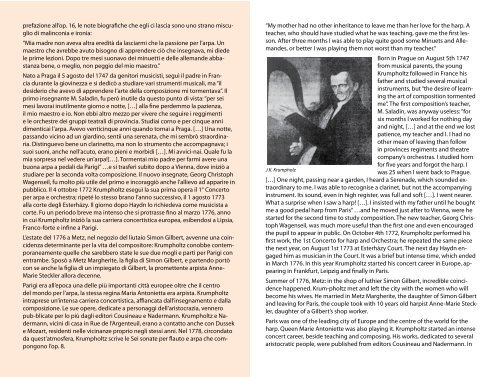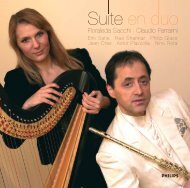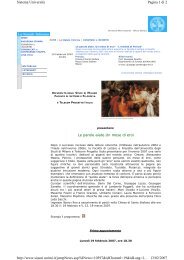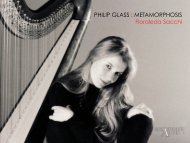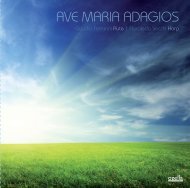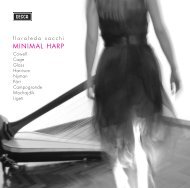download the booklet - Floraleda Sacchi
download the booklet - Floraleda Sacchi
download the booklet - Floraleda Sacchi
You also want an ePaper? Increase the reach of your titles
YUMPU automatically turns print PDFs into web optimized ePapers that Google loves.
prefazione all’op. 16, le note biografiche che egli ci lascia sono uno strano miscuglio<br />
di malinconia e ironia:<br />
“Mia madre non aveva altra eredità da lasciarmi che la passione per l’arpa. Un<br />
maestro che avrebbe avuto bisogno di apprendere ciò che insegnava, mi diede<br />
le prime lezioni. Dopo tre mesi suonavo dei minuetti e delle allemande abbastanza<br />
bene, o meglio, non peggio del mio maestro.”<br />
Nato a Praga il 5 agosto del 1747 da genitori musicisti, seguì il padre in Francia<br />
durante la giovinezza e si dedicò a studiare vari strumenti musicali, ma “il<br />
desiderio che avevo di apprendere l’arte della composizione mi tormentava”. Il<br />
primo insegnante M. Saladin, fu però inutile da questo punto di vista: “per sei<br />
mesi lavorai inutilmente giorno e notte, […] alla fine perdemmo la pazienza,<br />
il mio maestro e io. Non ebbi altro mezzo per vivere che seguire i reggimenti<br />
e le orchestre dei gruppi teatrali di provincia. Studiai corno e per cinque anni<br />
dimenticai l’arpa. Avevo venticinque anni quando tornai a Praga. […] Una notte,<br />
passando vicino ad un giardino, sentii una serenata, che mi sembrò straordinaria.<br />
Distinguevo bene un clarinetto, ma non lo strumento che accompagnava; i<br />
suoi suoni, anche nell’acuto, erano pieni e morbidi […]. Mi avvici-nai. Quale fu la<br />
mia sorpresa nel vedere un’arpa![…]. Tormentai mio padre per farmi avere una<br />
buona arpa a pedali da Parigi” …e si trasferì subito dopo a Vienna, dove iniziò a<br />
studiare per la seconda volta composizione. Il nuovo insegnate, Georg Christoph<br />
Wagenseil, fu molto più utile del primo e incoraggiò anche l’allievo ad apparire in<br />
pubblico. Il 4 ottobre 1772 Krumpholtz eseguì la sua prima opera il 1° Concerto<br />
per arpa e orchestra; ripeté lo stesso brano l’anno successivo, il 1 agosto 1773<br />
alla corte degli Esterházy. Il giorno dopo Haydn lo richiedeva come musicista a<br />
corte. Fu un periodo breve ma intenso che si protrasse fino al marzo 1776, anno<br />
in cui Krumpholtz iniziò la sua carriera concertistica europea, esibendosi a Lipsia,<br />
Franco-forte e infine a Parigi.<br />
L’estate del 1776 a Metz, nel negozio del liutaio Simon Gilbert, avvenne una coincidenza<br />
determinante per la vita del compositore: Krumpholtz conobbe contemporaneamente<br />
quelle che sarebbero state le sue due mogli e partì per Parigi con<br />
entrambe. Sposò a Metz Margherite, la figlia di Simon Gilbert, e partendo portò<br />
con se anche la figlia di un impiegato di Gilbert, la promettente arpista Anne-<br />
Marie Steckler allora decenne.<br />
Parigi era all’epoca una delle più importanti città europee oltre che il centro<br />
del mondo per l’arpa, la stessa regina Maria Antonietta era arpista. Krumpholtz<br />
intraprese un’intensa carriera concertistica, affiancata dall’insegnamento e dalla<br />
composizione. Le sue opere, dedicate a personaggi dell’aristocrazia, vennero<br />
pub-blicate per lo più dagli editori Cousineau e Nadermann. Krumpholtz e Nadermann,<br />
vicini di casa in Rue de l’Argenteuil, erano a contatto anche con Dussek<br />
e Mozart, residenti nelle vicinanze proprio negli stessi anni. Nel 1778, circondato<br />
da quest’atmosfera, Krumpholtz scrive le Sei sonate per flauto e arpa che compongono<br />
l’op. 8.<br />
“My mo<strong>the</strong>r had no o<strong>the</strong>r inheritance to leave me than her love for <strong>the</strong> harp. A<br />
teacher, who should have studied what he was teaching, gave me <strong>the</strong> first lesson.<br />
After three months I was able to play quite good some Minuets and Allemandes,<br />
or better I was playing <strong>the</strong>m not worst than my teacher.”<br />
Born in Prague on August 5th 1747<br />
from musical parents, <strong>the</strong> young<br />
Krumpholtz followed in France his<br />
fa<strong>the</strong>r and studied several musical<br />
instruments, but “<strong>the</strong> desire of learning<br />
<strong>the</strong> art of composition tormented<br />
me”. The first composition’s teacher,<br />
M. Saladin, was anyway useless: “for<br />
six months I worked for nothing day<br />
and night, […] and at <strong>the</strong> end we lost<br />
patience, my teacher and I. I had no<br />
o<strong>the</strong>r mean of leaving than follow<br />
in provinces regiments and <strong>the</strong>atre<br />
company’s orchestras. I studied horn<br />
for five years and forgot <strong>the</strong> harp. I<br />
J.K. Krumpholz<br />
was 25 when I went back to Prague.<br />
[…] One night, passing near a garden, I heard a Serenade, which sounded extraordinary<br />
to me. I was able to recognise a clarinet, but not <strong>the</strong> accompanying<br />
instrument. Its sound, even in high register, was full and soft […]. I went nearer.<br />
What a surprise when I saw a harp! […]. I insisted with my fa<strong>the</strong>r until he bought<br />
me a good pedal harp from Paris” …and he moved just after to Vienna, were he<br />
started for <strong>the</strong> second time to study composition. The new teacher, Georg Christoph<br />
Wagenseil, was much more useful than <strong>the</strong> first one and even encouraged<br />
<strong>the</strong> pupil to appear in public. On October 4th 1772, Krumpholtz performed his<br />
first work, <strong>the</strong> 1st Concerto for harp and Orchestra; he repeated <strong>the</strong> same piece<br />
<strong>the</strong> next year, on August 1st 1773 at Esterházy Court. The next day Haydn engaged<br />
him as musician in <strong>the</strong> Court. It was a brief but intense time, which ended<br />
in March 1776. In this year Krumpholtz started his concert career in Europe, appearing<br />
in Frankfurt, Leipzig and finally in Paris.<br />
Summer of 1776, Metz: in <strong>the</strong> shop of luthier Simon Gilbert, incredible coincidence<br />
happened. Krum-pholtz met and left <strong>the</strong> city with <strong>the</strong> women who will<br />
become his wives. He married in Metz Margherite, <strong>the</strong> daughter of Simon Gilbert<br />
and leaving for Paris, <strong>the</strong> couple took with 10 years old harpist Anne-Marie Steckler,<br />
daughter of a Gilbert’s shop worker.<br />
Paris was one of <strong>the</strong> leading city of Europe and <strong>the</strong> centre of <strong>the</strong> world for <strong>the</strong><br />
harp. Queen Marie Antoniette was also playing it. Krumpholtz started an intense<br />
concert career, beside teaching and composing. His works, dedicated to several<br />
aristocratic people, were published from editors Cousineau and Nadermann. In


